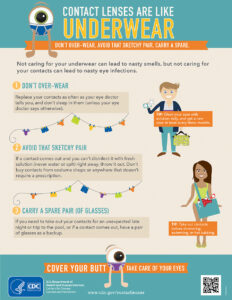Contact Lenses Stuck in Your Eye?
It’s happened to the best of us. You’re putting your contact lenses in, everything is going smoothly… and then suddenly one of them gets stuck under your eyelid. Or worse, both of them do! Or, even more horrible, you end up with 11 contact lenses stuck in your eye. So what gives?
11 Contact Lenses Stuck in Your Eye?!
It’s estimated that over 45 million people in the United States wear contact lenses. And while so many people utilize them, there are some risks to be aware of (in addition to them getting lost in your eyes). In this blog post, we’ll take a look at some of the most common problems associated with contact lens wear and what you can do to avoid them (like, just get LASIK instead).
Contact Lens Stuck in Your Eye Can Pose Problems
One of the most common risks associated with contact lens wear is eye infection. According to the CDC, one in five contact lens wearers have experienced an eye infection. Because contact lenses sit directly on your eye, they can trap bacteria and other harmful contaminants against your cornea. This increases your risk of developing an eye infection, which can lead to serious complications if left untreated. The best way to avoid this is to practice good hygiene when it comes to your contact lenses. This means always washing your hands before handling your contact lenses, never sharing your lenses with others, replacing them as often as recommended by your eye doctor, and don’t feed them after midnight (oh wait, that rule doesn’t apply here).
Droopy Eyelid (Ptosis)
This can occur from prolonged contact lens use as well. Ptosis (‘toe-sis’) is a condition where the upper eyelid droops over the eye, generally because of some flaw in the levator muscle responsible for controlling the eyelid.
Corneal Ulcers
A corneal ulcer is a deep break in the tissue of the cornea, and it can be caused by wearing contact lenses that don’t fit properly, a contact lens stuck in the eye, or by not cleaning your lenses properly. Corneal ulcers can cause significant pain and vision problems.
Keratitis & The Risk Contacts Can Bring
Wearing contact lenses also puts you at risk for developing keratitis, which is an inflammation of the cornea. Keratitis can be caused by several different things, including bacteria, viruses, fungi, and even amoeba (parasites that live in water). Symptoms of keratitis include pain, redness, teariness, and blurred vision. Another danger of wearing contact lenses for too long is that it can weaken your immune system. This is because the lenses provide a perfect environment for bacteria to grow. When bacteria build up on your lenses, they can cause serious infections like conjunctivitis (pink eye) and keratitis (inflammation of the cornea). In rare cases, these infections can even lead to blindness.
Corneal Abrasions
Another risk associated with contact lenses is corneal abrasions. This occurs when the contact lens rubs against the cornea, causing it to become scratched. Symptoms include pain, redness, tearing, and light sensitivity. Corneal abrasions usually heal on their own within a few days, but if you experience any of these symptoms, you should see your eye doctor right away.
Dry Eye
Finally, wearing contacts also puts you at risk for developing dry eyes. This can happen when contact lenses are left in the eye for too long and prevent tears from properly lubricating the eye. Symptoms of dry eyes include itching, redness, and a burning sensation. If you experience these symptoms, it’s important to remove your lenses and give your eyes a rest.
So, there you have it—multiple important reasons why you should take your contact lenses out as soon as possible if you plan on wearing them for more than a few hours, or ditch them all together. Remember, your eyes are delicate organs, so it’s important to take care of them and not create a breeding ground for bacteria with risky contacts!
If you’d like help getting out of your contacts with Modern LASIK, contact our team at (210) 585-2020 or by filling out your information here!
Be sure to talk to one of our doctors about not only the benefits of LASIK, but also any risks of LASIK that may pertain to your individual needs and circumstances.


